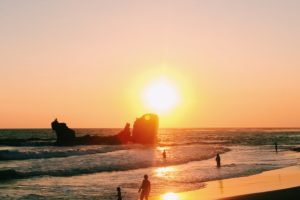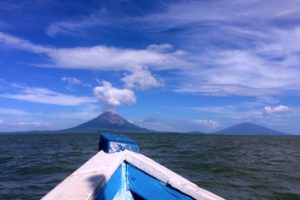After I left Livingston, in Guatemala, I didn’t come across anybody else who had made their way through Central America via this beautiful hidden town. Most people coming through from Belize had crossed the land border to get to Flores (and see the ruins at Tikal) and hadn’t travelled too far into the Belizean south. And the same vice versa for the travellers heading north through Central America.
I was so surprised that Livingston hadn’t been on more people’s itineraries as it was one of the most relaxing, undeveloped and genuinely peaceful places I’d visited in my whole trip. The two hostels I stayed at had their own different perks, but with one important feature in common: their proximity to the natural surroundings of the river and the jungle, discretely constructed to blend into the environment around. Getting to Livingston was also fairly easy from Belize and the boat trip inland from the sea was breathtaking, with leafy jungle-clad walls of rock on either side of you towering above you to form a natural corridor through which the boat sped.
In Hopkins, I checked out relatively early in the morning and went over to the only bus stop in town. Hopkins town is basically at the end of a dirt road that branches off from the main highway (one lane for northbound vehicles and one lane for southbound vehicles). I’d been hanging around at the bus stop for at least an hour until a bus finally arrived that would take me to the end of the dirt road (it would have been about a forty minute walk in the heat, which I didn’t feel like doing with my rucksack).
I’d left a few small things in Dangriga (heavy duty insect repellent and a towel, nothing particularly important but useful) so I thought I could catch a bus and swing by as it was only half an hour away, and then go from Dangriga back down south until I reached Guatemala. How wrong I was. In London, it’s common to hear people complaining of a bus not coming for a long time and then having three or four all turn up at once (or twenty). In Belize, buses are similar to the point where a bus doesn’t come for a long time. And then just doesn’t come at all.
Eventually after another hour or so of waiting, I spotted a dusty red bus slowly approaching from the direction that I wanted to go. As it became larger, I could gradually make out the text on the front of the bus, ‘PUNTA GORDA’. I decided that my 95% DEET spray and my sister’s travel towel (sorry Emma) were not worth sacrificing the rest of my youth for, especially not on the side of a dusty highway in the middle of Belizean nowhere. I grabbed my rucksack and climbed aboard. The fare down to Punta Gorda, ‘Fat Point’, wasn’t much, around five US dollars at the most, and I was comfortably wedged into my seat with my rucksack on the rack above. The entire journey took around 3 hours, creaking and bouncing, and it was around 3pm by the time I arrived in Punta Gorda.
A border guard told me the last ferry had already crossed but pointed at a Guatemalan man who could take me over instead. The man told me to wait for another ten minutes and meet him back at the border crossing spot, with cash for the lancha in hand. I don’t recall it being much – perhaps around $10 (there was also an exit tax to pay at the Belizean immigration office). After immigration there was an old woman waiting on the deck, I exchanged the rest of my Belizean dollars into Guatemalan quetzales and my new crewmates and I clambered onboard.
The captain arranged his four passengers (two Belizean reggae musicians in Matrix-style leather coats, a large Guatemalan man and myself) in the tiny lancha for optimum balance over the rough ocean crossing. He shouted out to his son, a small boy barely a day over the age of ten, to untie the boat from the dock, and we were off.
The journey was about 40 minutes, rough in some parts but nothing unbearable, especially considering the circumstances. When we arrived in Livingston, which is a tiny town in itself at the edge of the harbour, I looked for somewhere to eat. I had a deliciously fresh pescado a la plancha at Happy Fish and the portion was large enough for me to take away and have for dinner too. At the table behind me, also having some late lunch, sat a NZ/US couple whom I’d briefly met at the bus stop all the way back in Hopkins. They didn’t yet know where they were staying so I told them about the place I had booked, halfway between Livingston and Puerto Barrios on the river, and they decided to come along too.
The staff at Happy Fish were so kind, they’d said that we wouldn’t have to rush lunch in order to get to the hostel on the last ferry of the day (that makes multiple stops along the river) and that they had a boat that could take us. We paid 115 quetzales each for the boat, which was so worth it as the view was stunning. The sheer green cliffs on either side of us, along with the cold white spray of the speedboat and the rosy glow of the setting sun ahead made me feel like we were about to arrive at Jurassic Park, it was so serene and otherworldly.

By the time we docked the lancha at Round House Hostal (50 quetzales a night/$8 dollars) and found ourselves on dry land again, it was already dark. There were only three other guests staying, an English couple and a German lady, so the entire place was very peaceful. This was such an amazing hostel and the staff were so kind and funny. Meals were communal (and delicious) and you could pay for everything on your tab at the end of your stay, including plenty of chilled beer. There was no wifi, a refreshing change that made me appreciate the beauty of the natural surroundings all the more.



The amazing thing about Round House Hostal is that if you stepped off the edge of the decking on the veranda, you’d fall right into the river. The whole hostel is on the river bank, and there are hammocks and chairs on a double-storey deck that’s built right in the water for all your relaxation needs. From here, you might even be able to spot the two manatees that live right in the water below, sometimes allowing themselves to be seen by lucky guests.
The only way in and out of the hostel was via the river out front. I rented a kayak the next morning and paddled 40 minutes upstream to Agua Caliente with the couple I’d first met in Hopkins. This was meant to be a natural sulphur hot spring for bathing with a complex system of caves and pools. Although this was technically what it was, and our guide was a lovely local man whose Q’eqchi’ (a Mayan language) was better than his Spanish, we couldn’t help feeling that the journey was much more pleasant than the destination. There are two small thermal springs, right by where the boat docks, but the abundance of tourists coming to and fro and the noise and smell of the boat engines doesn’t make it a bath you want to stew in for too long. The caves were fun to explore but definitely not as amazing as the natural surroundings all around outside.



We spent some time here and then climbed back into our kayaks for the easy journey back. We saw three Q’eqchi’ boys fishing out a hollowed out wooden canoe and waved. As we floated back down to our hostel, we passed more Mayan communities, all so friendly and excited to say hola and smile.

Sitting in a hammock at Finca Tatin
We arrived back at our hostel and were told that they were suddenly expecting a giant party of young Guatemalans who would be arriving later in the evening. The staff offered to move us to their sister hotel Finca Tatin, for no extra cost, so that we could continue enjoying our peaceful Livingston existence. Finca Tatin was further upstream, and was a more upscale version of Round House, with a beautiful wooden lobby area and hammocks, even more hidden away in dense jungle (so much so that a passerby could only guess there was something there by the wooden deck built on the river). All of the rooms were arranged as separate huts, short walks away from the main lobby area. I was given an entire dormitory to myself with an ensuite bathroom, a nice, private change (literally) that I hadn’t even realised I’d been missing.

Walkway to Finca Tatin from the river
In the morning, I boarded a colectiva (taxi boat) and started my journey further into Guatemala. Next stop: Semuc Champey.
Note:
I didn’t go over to Tikal and Flores due to time constraints, although I’ve heard it’s also an awesome thing to do if you’re into overgrown ruins nestled in dense forest. I’d seen a lot of temples over in Mexico and climbed the ruins at Cobá (a must see), which sounded like a similar sort of affair. I’m glad I made the decision to enter Guatemala through the port at Livingston but if you have the time, you can definitely make it over to both, possibly through Belize.
The difficulty of trying to put both these spots in your travel plans if you’re only sticking to Guatemala is that you would most likely have to backtrack to Guatemala City to get from one to the other, which does add a day onto your travelling time. Going through to Punta Gorda (Belize) from Livingston (Guatemala) by boat and then heading over to Flores (Guatemala) would also involve some backtracking (if you’re planning on heading straight up through Central America) as there are only a few major highways in the country, but the distances would be far smaller. You’d then be paying an extra exit tax for leaving Belize twice but this might be worth it for the time saved.
In any case, I’d say give Livingston a chance and make a little space for it in your plans. I’m sure you won’t regret it.
Go back to Central America here





